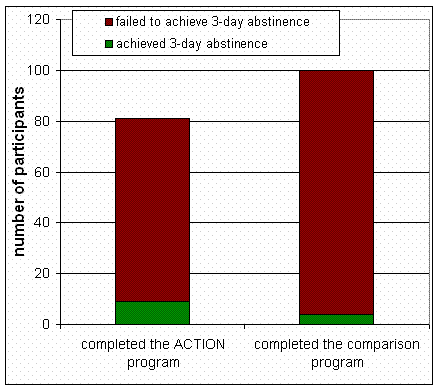ASHES, Vol. 5(8) – Lessons learned from an evaluation of a smoking cessation program
Adolescent smoking rates in tobacco-growing states are higher than the national average (Eaton et al., 2008). Adolescents from these communities face unique social pressures that deter them from quitting smoking. The Adolescent Cessation of Tobacco: Independent of Nicotine (ACTION) program was designed to help adolescents who live in tobacco-growing communities stop using tobacco by prompting them to reflect on social pressures not to quit. This week’s ASHES reviews a recent study (Stein-Seroussi, Stockton, Brodish, & Meyer, 2009) which evaluates the efficacy of ACTION, and, in doing so, highlights several practical issues that can hamper efforts to evaluate school-based intervention programs.
Methods
• Participants were 268 adolescent smokers recruited from 14 schools in Kentucky, North Carolina, and Ohio.
• Assignment to a program was by school. Seven schools received the ACTION program and seven received the comparison program. Investigators randomly assigned ACTION to the schools, using stratification within state to assure comparable school assignments.
• There were three assessment periods: pre-test (up to one week before the programs began); post-test (no more than thee days after the programs ended); and follow-up (three months after the programs ended).
• 261 students contributed useable baseline data; 220 (88%) of them contributed post-test data and 181 (69%) contributed follow-up data.
• At each assessment period, students completed a self-report of tobacco abstinence online and provided saliva samples to test for continine (a metabolite of nicotine). Salivary cotinine can be detected up to 72 h after cigarette and smokeless tobacco use.
• There were two abstinence outcomes: 3-day (self-report of 3-day abstinence confirmed by negative continine sample) and 7-day (self-report of 7-day abstinence confirmed by negative continine sample).
Data Analysis
• The authors report results from two types of analyses: intent-to-treat (ITT) and using all available data. Here we report results from the latter set of analyses, which are less conservative.
• The authors used mixed model analyses to account for the intra-class correlation (ICC), or non-independence that resulted from student membership in particular classrooms and schools.
Results
• Many participants falsely reported abstinence (61% at post-test and 38% at follow-up). Results reported here only include continine-verified abstinence.
• At post-test, six students in the ACTION condition (5.6%) and nine students in the comparison condition (7.4%) achieved 3-day abstinence. Four students in the ACTION condition (3.7%) and three in the comparison condition (2.5%) achieved 7-day abstinence. Group differences were not significant for 3-day abstinence (OR=1.05; CI = 0.35-3.20) and 7-day abstinence (OR=1.56; CI = 0.32-7.71).
• At follow-up, nine students in the ACTION condition (11.1%) and four students in the comparison condition (4%) achieved 3-day abstinence. Nine in the ACTION condition (11.1%) and three in the comparison condition (3%) achieved 7-day abstinence. Group differences were significant for both 3-day abstinence (OR=4.46; CI = 1.02-19.52; p < 0.05) and 7-day abstinence (OR=4.44; CI = 1.01-19.49; p < 0.05). See Figure 1.
 Figure. Proportion of participants who achieved and failed to achieve 3-day verified abstinence at follow-up, as a function of program completed. Based on data provided by Stein-Seroussi et al. (2009). Click image to enlarge.
Figure. Proportion of participants who achieved and failed to achieve 3-day verified abstinence at follow-up, as a function of program completed. Based on data provided by Stein-Seroussi et al. (2009). Click image to enlarge.
Limitations
• The original protocol called for enrollment of 336 students. However, only 268 students (80%) actually participated. This sample size reduced statistical power and, consequently, the ability to detect significant group differences.
• Also, according to the original protocol, participants were supposed to be interested in voluntarily participating in a study of smoking cessation. However, in several schools, participation was offered as an alternative to suspension for using tobacco on school grounds. Therefore, roughly 17% of participants indicated at the outset that they were not at all motivated to quit smoking. This might have diminished the effectiveness of both smoking cessation programs and limited the likelihood of detecting between-group differences.
• Randomizing within classes (rather than schools) would have provided more power to detect significant effects. However, this would come at the expense of potential contamination between groups.
• Program fidelity was low. Videotapes of the ACTION sessions revealed that on average, teachers only covered about half of the intended content. They also introduced their own content.
• Results suggest that the effects of the ACTION program might become stronger over time. This claim is difficult to evaluate, however, because there was only one follow-up assessment at 90 days.
Conclusions
The group differences in abstinence rates at follow-up suggest that the ACTION program has promise as a smoking cessation program for adolescents from tobacco-growing communities. Future research in this area should seek to (1) increase statistical power (by enrolling larger samples and decreasing attrition rates), (2) decrease within-group variability (by ensuring program fidelity and standardizing participant enrollment procedures), and (3) increase the length of the follow-up period.
References
Eaton, D. K., Kann, L., Kinchen, S., Shanklin, S., Ross, J., Hawkins, J., et al. (2008). Youth risk behavior surveillance–United States, 2007. MMWR Surveill Summ, 57(4), 1-131.
Stein-Seroussi, A., Stockton, L., Brodish, P., & Meyer, M. (2009). Randomized controlled trial of the ACTION smoking cessation curriculum in tobacco-growing communities. Addictive Behaviors, 34(9), 737-743.
What do you think? Please use the comment link below to provide feedback on this article.